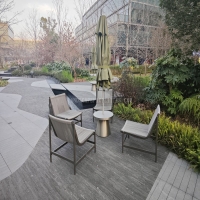Welcome to the website for landscape facilities products and knowledge.
What are the acoustic properties of different landscape sofa materials, and how do they affect outdoor noise levels?
When designing outdoor spaces, the acoustic properties of landscape sofa materials play a crucial role in managing noise levels. Different materials interact with sound waves in unique ways, influencing the overall auditory experience.
1. Wood: Natural wood, such as teak or cedar, offers moderate sound absorption due to its porous structure. It helps diffuse high-frequency noises but may reflect lower frequencies, creating a balanced acoustic environment.
2. Metal: Aluminum and steel are highly reflective, amplifying sounds and increasing noise levels. These materials are less ideal for quiet spaces but can be paired with sound-absorbing elements like cushions to mitigate echoes.
3. Rattan/Wicker: These woven materials provide decent sound dampening by trapping sound waves within their fibrous texture. They are suitable for creating softer, quieter seating areas.
4. Concrete: Dense and rigid, concrete reflects most sound waves, leading to higher noise levels. However, combining it with upholstered cushions or plants can improve its acoustic performance.
5. Fabric-Upholstered Foam: This combination excels in sound absorption, significantly reducing outdoor noise. It’s ideal for creating serene, low-noise zones in busy environments.
By selecting materials with the right acoustic properties, designers can effectively control outdoor noise levels, enhancing comfort and usability. Combining reflective and absorbent materials often yields the best results for a harmonious soundscape.
Related search:

Recommendation
Metal structure rattan chair without armrests for single person, with woven seat and backrest.